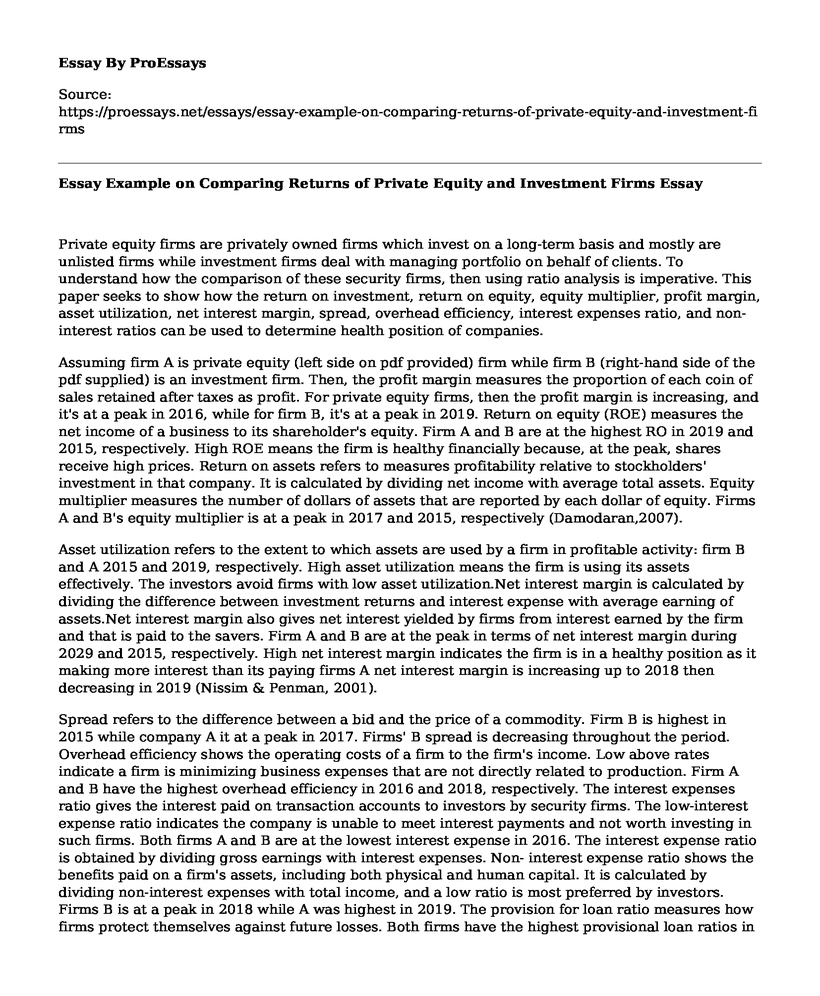Private equity firms are privately owned firms which invest on a long-term basis and mostly are unlisted firms while investment firms deal with managing portfolio on behalf of clients. To understand how the comparison of these security firms, then using ratio analysis is imperative. This paper seeks to show how the return on investment, return on equity, equity multiplier, profit margin, asset utilization, net interest margin, spread, overhead efficiency, interest expenses ratio, and non-interest ratios can be used to determine health position of companies.
Assuming firm A is private equity (left side on pdf provided) firm while firm B (right-hand side of the pdf supplied) is an investment firm. Then, the profit margin measures the proportion of each coin of sales retained after taxes as profit. For private equity firms, then the profit margin is increasing, and it's at a peak in 2016, while for firm B, it's at a peak in 2019. Return on equity (ROE) measures the net income of a business to its shareholder's equity. Firm A and B are at the highest RO in 2019 and 2015, respectively. High ROE means the firm is healthy financially because, at the peak, shares receive high prices. Return on assets refers to measures profitability relative to stockholders' investment in that company. It is calculated by dividing net income with average total assets. Equity multiplier measures the number of dollars of assets that are reported by each dollar of equity. Firms A and B's equity multiplier is at a peak in 2017 and 2015, respectively (Damodaran,2007).
Asset utilization refers to the extent to which assets are used by a firm in profitable activity: firm B and A 2015 and 2019, respectively. High asset utilization means the firm is using its assets effectively. The investors avoid firms with low asset utilization.Net interest margin is calculated by dividing the difference between investment returns and interest expense with average earning of assets.Net interest margin also gives net interest yielded by firms from interest earned by the firm and that is paid to the savers. Firm A and B are at the peak in terms of net interest margin during 2029 and 2015, respectively. High net interest margin indicates the firm is in a healthy position as it making more interest than its paying firms A net interest margin is increasing up to 2018 then decreasing in 2019 (Nissim & Penman, 2001).
Spread refers to the difference between a bid and the price of a commodity. Firm B is highest in 2015 while company A it at a peak in 2017. Firms' B spread is decreasing throughout the period. Overhead efficiency shows the operating costs of a firm to the firm's income. Low above rates indicate a firm is minimizing business expenses that are not directly related to production. Firm A and B have the highest overhead efficiency in 2016 and 2018, respectively. The interest expenses ratio gives the interest paid on transaction accounts to investors by security firms. The low-interest expense ratio indicates the company is unable to meet interest payments and not worth investing in such firms. Both firms A and B are at the lowest interest expense in 2016. The interest expense ratio is obtained by dividing gross earnings with interest expenses. Non- interest expense ratio shows the benefits paid on a firm's assets, including both physical and human capital. It is calculated by dividing non-interest expenses with total income, and a low ratio is most preferred by investors. Firms B is at a peak in 2018 while A was highest in 2019. The provision for loan ratio measures how firms protect themselves against future losses. Both firms have the highest provisional loan ratios in 2016 (Babalola & Abiola, 2013).
Since pandemic contributes to a difficult period in the economy, then during this period, most firms face challenges in daily operations. This translates to low business operations meaning the firms are faced with the challenge of making profits. In such periods firms need to meet costs for their survival. (Heyman and et al. ,2015).
Conclusion
In conclusion, ratio analysis can be used extensively to determine the health position of firms. Investors can rely on this knowledge to make profound judgments and conclusions when seeking high returns on their investments.
References
Babalola, Y. A., & Abiola, F. R. (2013). Financial ratio analysis of firms: A tool for decision making. International journal of management sciences, 1(4), 132-137
Damodaran, A. (2007). Return on capital (ROC), return on invested capital (ROIC), and return on equity (ROE): Measurement and implications. Return on Invested Capital (ROIC) and Return on Equity (ROE): Measurement and Implications
Heymann, D. L., Chen, L., Takemi, K., Fidler, D. P., Tappero, J. W., Thomas, M. J., ... & Kalache, A. (2015). Global health security: the broader lessons from the West African Ebola virus disease epidemic. The Lancet, 385(9980), 1884-1901.1.
Krohmer, P., Lauterbach, R., & Calanog, V. (2009). The bright and dark side of staging: Investment performance and the varying motivations of private equity firms. Journal of Banking & Finance, 33(9), 1597-1609.
Nissim, D., & Penman, S. H. (2001). Ratio analysis and equity valuation: From research to practice. Review of accounting studies, 6(1), 109-154.
Cite this page
Essay Example on Comparing Returns of Private Equity and Investment Firms. (2023, Jul 12). Retrieved from https://proessays.net/essays/essay-example-on-comparing-returns-of-private-equity-and-investment-firms
If you are the original author of this essay and no longer wish to have it published on the ProEssays website, please click below to request its removal:
- Auditing of the AIG Company
- Essay Sample on Diversified Investment Portfolio
- Effects of Implementing the VAT Collection System in UAE and Other Countries Around the World
- How Cryptocurrency and Blockchain Technology Has Changed Business Essay
- Analysis of Business Profitability Paper Example
- International Breweries Plc Present Situation and the Need for Change
- Goldman Sachs Overpays for 1MDB Assets: Tanjong, Genting, and Putrajaya - Essay Sample







